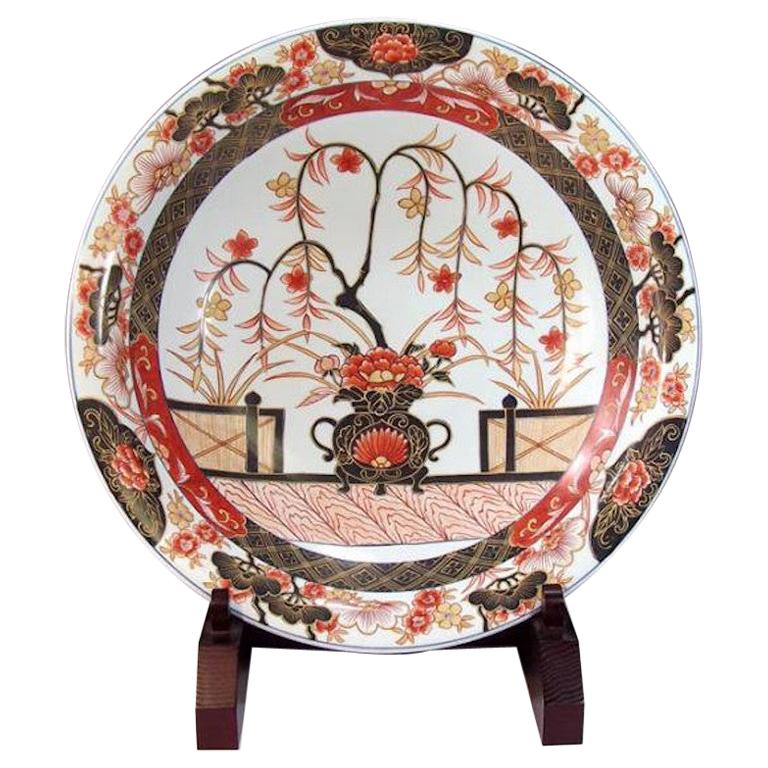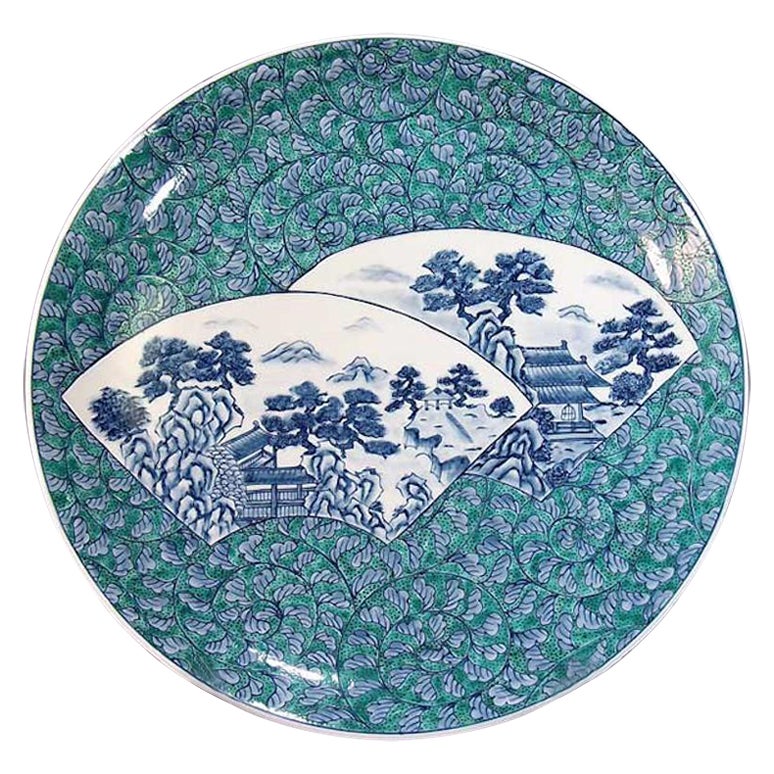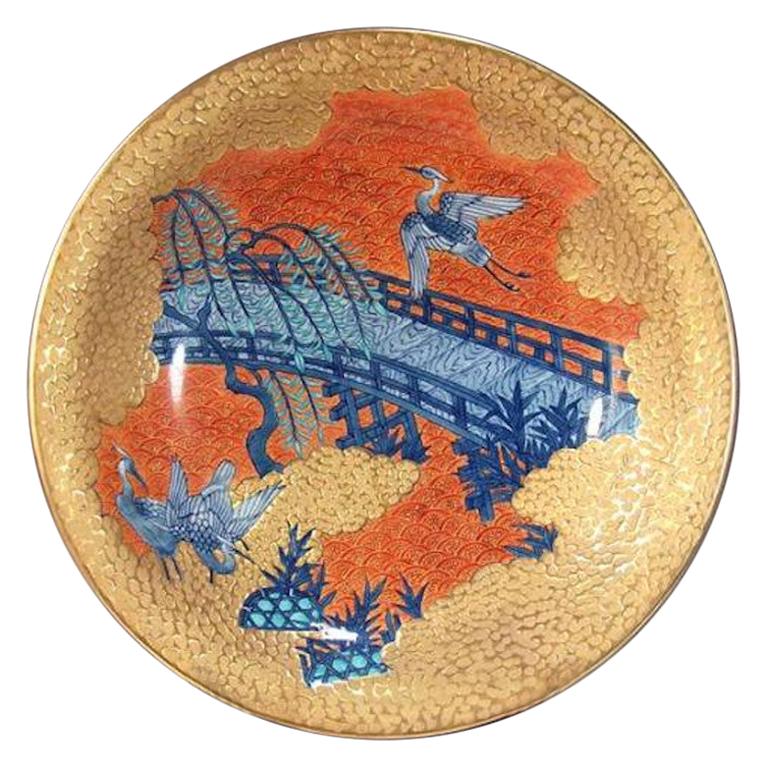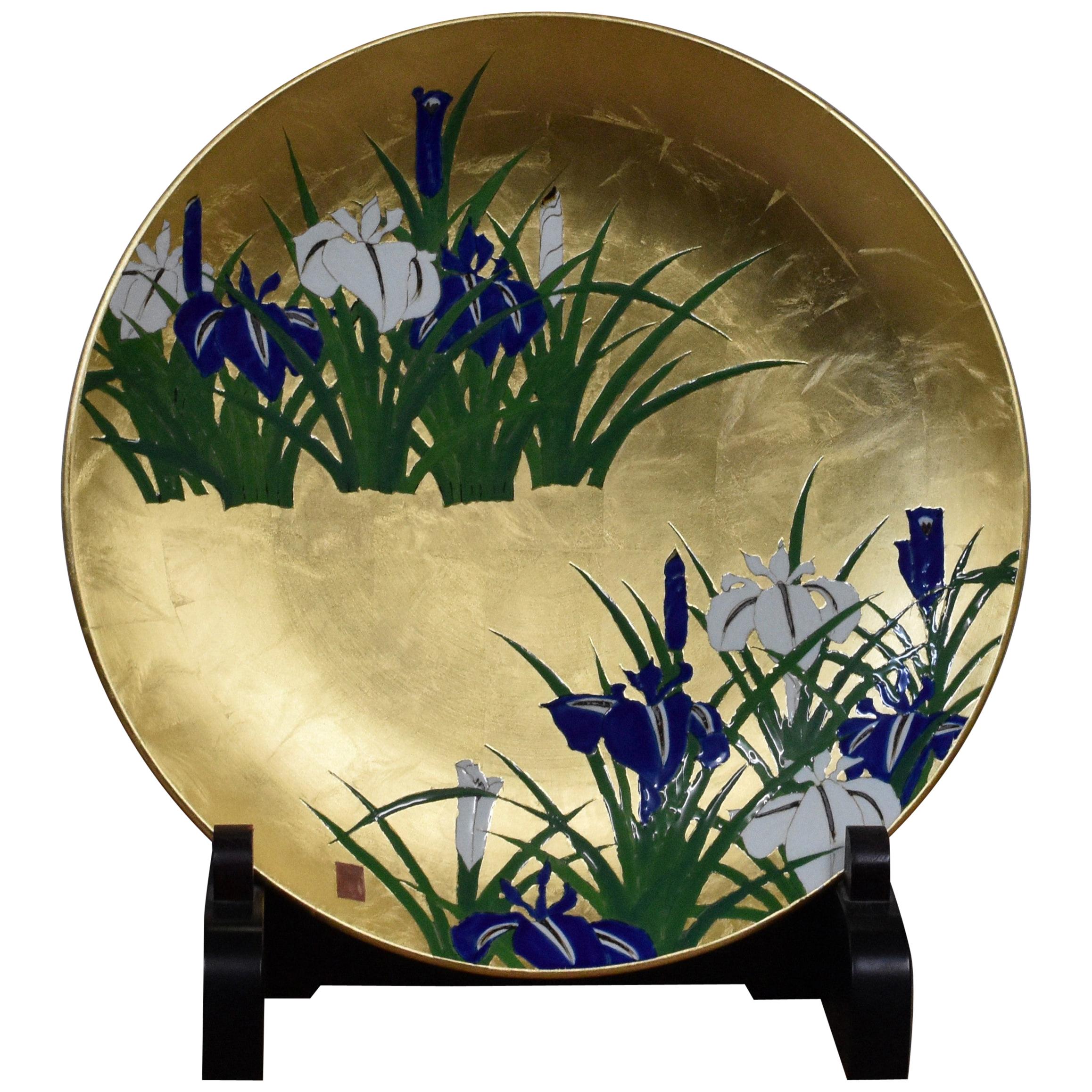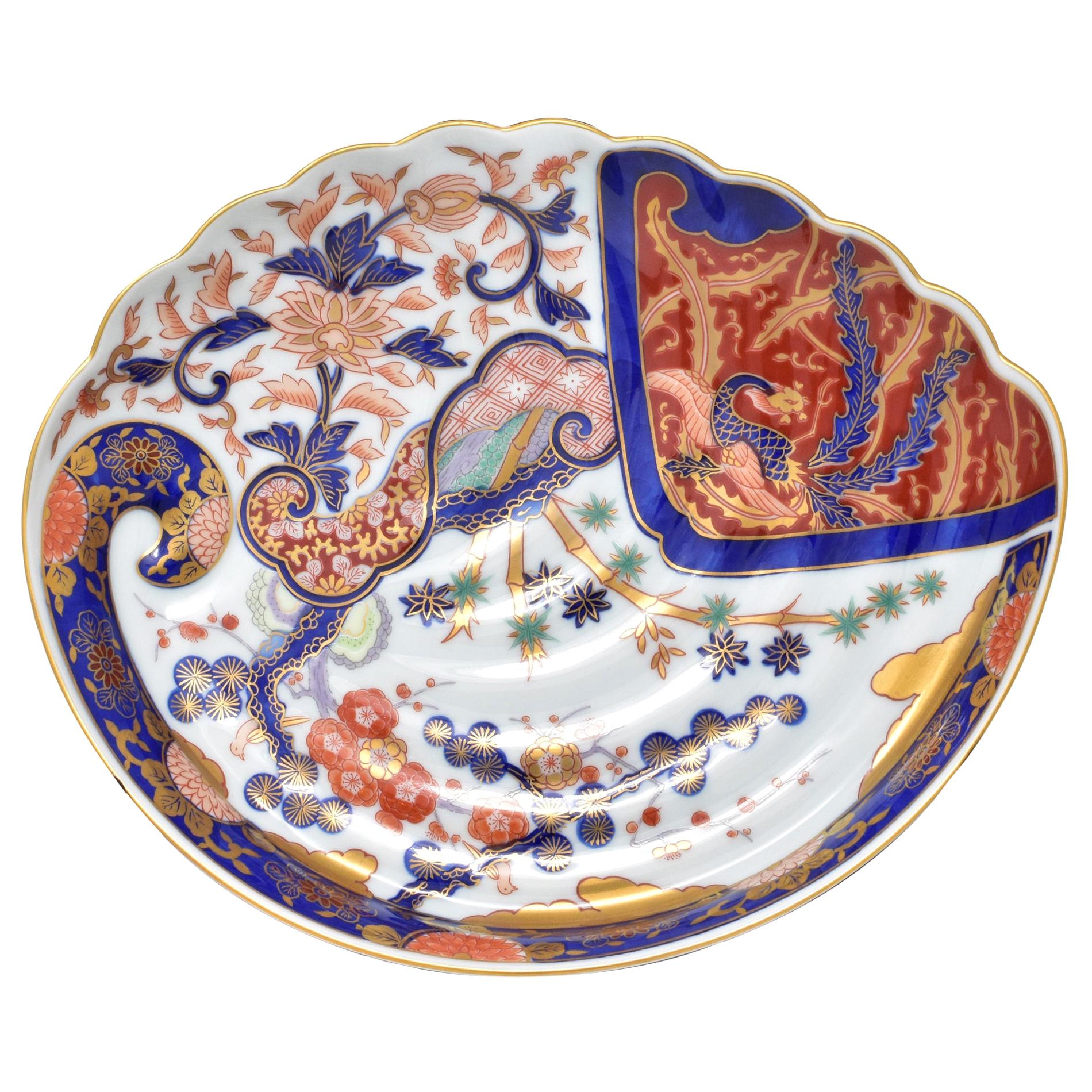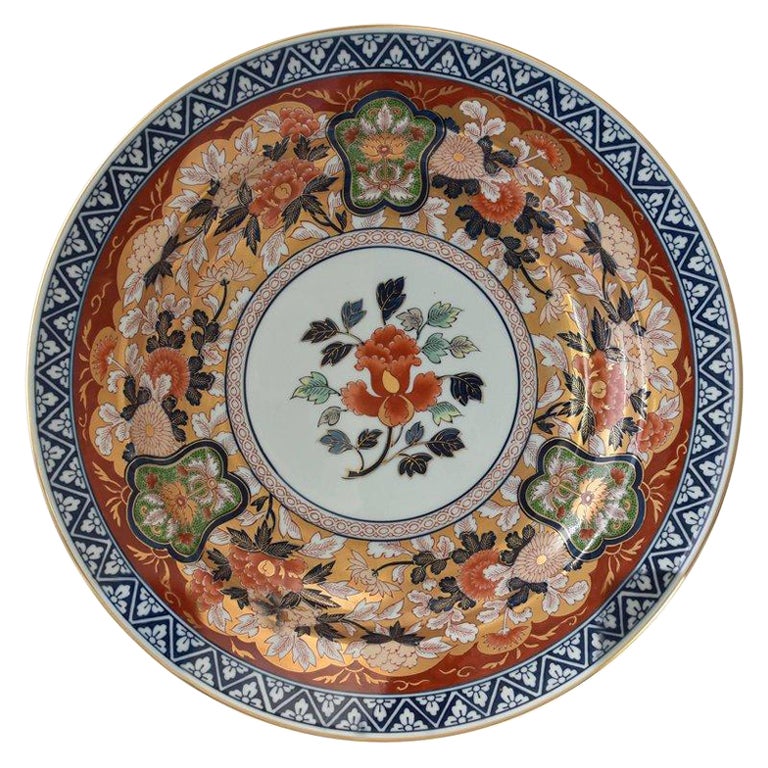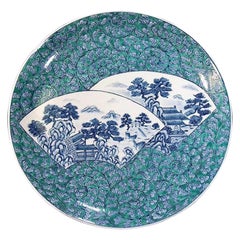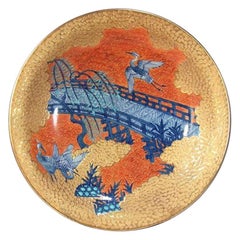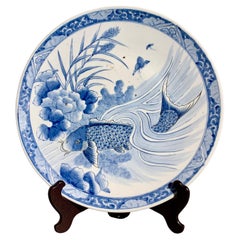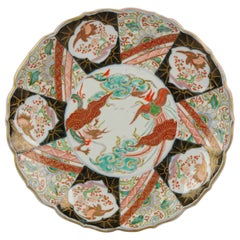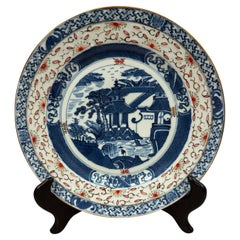Items Similar to Japanese Blue Green Gold Cream Porcelain Charger by Contemporary Master Artist
Want more images or videos?
Request additional images or videos from the seller
1 of 7
Japanese Blue Green Gold Cream Porcelain Charger by Contemporary Master Artist
$4,250
£3,249.35
€3,742.60
CA$5,955.55
A$6,648.81
CHF 3,483.88
MX$81,388.02
NOK 44,245.30
SEK 41,717.70
DKK 27,931.38
About the Item
Exceptional contemporary Japanese Ko-Imari style large decorative porcelain charger, hand painted in gold, blue, green, pink, cream and red, a signed masterpiece by widely acclaimed award-winning master porcelain artist of the Imari-Arita region of Japan. In 2016, the British Museum added a work by this artist to its collection of contemporary Japanese porcelain in the Imari-Arita polychrome enamel tradition. This artist is the recipient of numerous awards for his notable porcelain work and his unique gold and platinum work on porcelain. The artist's profile is available upon request.
This captivating charger in Ko-Imari style dramatically showcases a kirin, a mythical Chinese giraffe, and the "sho-chiku-bai" motif. The auspicious "Sho-chiku-bai" or "The Three Friends of Winter" is a cherished theme with a long history in Japan and China. It literally means pine, bamboo and plum. Pine and bamboo that can withstand the wind and snow and extreme cold, and the plum that blooms ahead of other plants in spring are symbolic of longevity, nobility. A wide striking band with a flower motif showcasing Peonies, Chrysanthemums, Pine trees, Bamboo, Plum blossoms and Cranes decorates the rim of the charger.
from the latter half of the 17th century to the latter half of the 18th century all porcelain pieces produced in the kilns in Hizen region of southern Japan were exported from the port of Imari to European countries . For this reason Hizen ceramics were called Imari (and later referred to as Ko-Imari meaning Old Imari) inside and outside the country, adopting the name of the port. The colors are deep, and red and gold paints are used luxuriously. Ko-Imari reflects the spirit of the Genroku era, which was economically abundant. Ko-Imari porcelain exported to Europe was prized by being displayed in royal palaces and aristocratic mansions. This graceful style that fascinated Europe in the 17th century still continues to adorn many of today's Imari-Arita porcelain.
“Fired-on gold,” his signature style highlights unique techniques for incorporating gold and platinum into the hand painting and multiple firing processes that yield a stunningly opulent look. The polychrome overglaze is fired at 800 degrees, followed by the application of gold and platinum that are fired at slightly lower temperature to maintain the luster of the precious metals. As a result, a single piece may undergo as many as 5-10 firings. His profile is available upon request.
This striking large decorative porcelain charger includes a stand and comes in a custom made wooden box signed by the artist.
Dimensions: D 18 in, H 2 in.
- Dimensions:Height: 2 in (5.08 cm)Diameter: 18 in (45.72 cm)
- Style:Other (In the Style Of)
- Materials and Techniques:
- Place of Origin:
- Period:
- Date of Manufacture:Contemporary
- Production Type:New & Custom(Limited Edition)
- Estimated Production Time:Available Now
- Condition:
- Seller Location:Takarazuka, JP
- Reference Number:Seller: CVFK1stDibs: LU2771321517152
About the Seller
5.0
Vetted Professional Seller
Every seller passes strict standards for authenticity and reliability
Established in 2009
1stDibs seller since 2017
231 sales on 1stDibs
- ShippingRetrieving quote...Shipping from: Takarazuka, Japan
- Return Policy
Authenticity Guarantee
In the unlikely event there’s an issue with an item’s authenticity, contact us within 1 year for a full refund. DetailsMoney-Back Guarantee
If your item is not as described, is damaged in transit, or does not arrive, contact us within 7 days for a full refund. Details24-Hour Cancellation
You have a 24-hour grace period in which to reconsider your purchase, with no questions asked.Vetted Professional Sellers
Our world-class sellers must adhere to strict standards for service and quality, maintaining the integrity of our listings.Price-Match Guarantee
If you find that a seller listed the same item for a lower price elsewhere, we’ll match it.Trusted Global Delivery
Our best-in-class carrier network provides specialized shipping options worldwide, including custom delivery.More From This Seller
View AllJapanese Blue Gold Cream Porcelain Charger by Contemporary Master Artist
Located in Takarazuka, JP
Exquisite contemporary Japanese Ko-Imari style large decorative porcelain charger, hand painted in gold, blue, cream and red, a signed masterpiece by widely acclaimed award-winning m...
Category
21st Century and Contemporary Japanese Edo Decorative Dishes and Vide-Poche
Materials
Porcelain
Japanese Contemporary White Blue Porcelain Charger by Master Artist, 2
Located in Takarazuka, JP
Exctraordinary contemporary Japanese porcelain decorative charger, extremely intricately hand painted in an auspicious karakusa pattern...
Category
21st Century and Contemporary Japanese Meiji Decorative Dishes and Vide-...
Materials
Porcelain
Japanese Gold Blue Porcelain Charger by Contemporary Master Artist
Located in Takarazuka, JP
Exquisite large contemporary signed dimpled decorative porcelain vase, a stunning piece gilded and hand painted by highly acclaimed porcelain artist of Japan’s Imari-Arita region. Th...
Category
21st Century and Contemporary Japanese Decorative Dishes and Vide-Poche
Materials
Gold
Japanese Contemporary Blue Gold Leaf Green Porcelain Charger by Master Artist, 3
Located in Takarazuka, JP
Superb museum quality Japanese large contemporary gold leaf porcelain charger, beautifully hand painted in a stunning iris motif in vivid purple/blue, white and green on an exquisite...
Category
21st Century and Contemporary Japanese Meiji Decorative Dishes and Vide-...
Materials
Gold Leaf
Japanese Contemporary Blue Gold White Porcelain Charger
Located in Takarazuka, JP
Unique contemporary Japanese Ko-Imari (old Imari) style charger stunningly gilded and hand painted on an exquisite clam shape porcelain, crafted and signed by renowned Kiln of the Im...
Category
21st Century and Contemporary Japanese Meiji Decorative Dishes and Vide-...
Materials
Gold
Japanese Blue Gold Red Porcelain Charger by Celebrated Kiln
Located in Takarazuka, JP
Exquisite contemporary gilded porcelain deep charger with a unique deep charger shape in blue, red and gold is created in a renowned Kiln of the Imari-Arita region of southern Japan ...
Category
21st Century and Contemporary Japanese Meiji Decorative Dishes and Vide-...
Materials
Gold
You May Also Like
Large Japanese Blue and White Arita Porcelain Charger, Edo Period, 19th C, Japan
Located in Austin, TX
A large Japanese blue and white decorated Arita porcelain charger, Edo Period, early 19th century, Japan.
The large and shallow blue and white Arita porcelain charger measures 18 ...
Category
Antique Early 19th Century Japanese Edo Ceramics
Materials
Porcelain
Antique Edo Period Imari Gold Plate Antique Porcelain Chinese, 18/19th Century
Located in Amsterdam, Noord Holland
A very lovely and richly decorated Imari dish with golden touches.
Additional information:
Material: Porcelain & Pottery
Type: Plates
Color: Imari
Region of Origin: China
Period: 18...
Category
Antique 18th Century Chinese Decorative Dishes and Vide-Poche
Materials
Porcelain
$423 Sale Price
20% Off
Early 20th Century Antique Chinese Blue and White Porcelain Plate
Located in Pomona, CA
A superb Chinese hand painted blue & white porcelain rice grain pattern plate. This hand crafted Chinese porcelain plates is absolutely stunning. Finley hand painted rice grain scene...
Category
Early 20th Century Chinese Chinese Export Ceramics
Materials
Porcelain
$412 Sale Price
25% Off
Antique 18th Century Chinese Porcelain Plate with Regency Style Overdecorating
Located in Amsterdam, Noord Holland
A very nicely made piece of 18th century porcelain decorated with a beautiful scene. Underglaze blue and overglaze other enamels done later in Europe.
We have also added a picture of how a similar original Blue and white dish would have looked like.
This is an example of British overdecoration.Provenance:Provenance: Doyle Sep 27, 2024 11:00 Boston Collects, Lot 1083 Six Chinese Porcelain Table Items
18th and 19th centuries Estate / Collection: Property of a Jamestown, Rhode Island Collector
Often seen as ugly and black sheep of the porcelain world. British 1810-1820 Clobbered wares deserve better as they are historically very interesting. So lets call them George the IV or Regency Taste redecorated porcelain. And leave the clobbered behind us as it does no justice to what they are at all. Its not that because we live in a time were these super funky colours are out of taste that we should hate on these pieces.
A short history!
During the early 19th century, the Prince Regent (later King George IV) played a key role in cultivating a taste for the exotic Orient among the British elite, influencing interior design during the Regency era. His lavish projects, such as the Royal Pavilion in Brighton, epitomized this fascination. The Pavilion, with its blend of Indian, Chinese, and Gothic elements, became a symbol of the Prince’s extravagant taste. The interiors featured Chinese wallpaper, Indian textiles, and oriental furniture, reflecting the era’s growing interest in Chinoiserie and other oriental-inspired designs.
This trend extended to the decorative arts, where clobbered Chinese porcelain—originally blue-and-white pieces—was reimagined with bright reds, golds, greens, and dragons to cater to the new European tastes. These colorful repainted pieces symbolized wealth, sophistication, and an affinity for the exotic, perfectly complementing the bold and opulent interiors of the time. The dragon, a powerful symbol in Chinese culture, was a recurring motif in these porcelain pieces, further aligning with the Regency’s romanticized view of the Orient. George IV’s penchant for luxury, eccentricity, and vibrant decoration influenced the wider aristocratic society, and clobbered porcelain...
Category
Antique 18th Century Chinese Regency Decorative Dishes and Vide-Poche
Materials
Porcelain
$1,594 Sale Price
20% Off
Antique Japanese Porcelain Meiji Period Polychrome Dish 19th Century
Located in Amsterdam, Noord Holland
Sharing with you this unusual and magnificent bowl from the Meiji period (19th century). It has a very interesting and lovely blue and gold scene
Unmarked at the base.
Additional in...
Category
Antique 19th Century Japanese Meiji Decorative Dishes and Vide-Poche
Materials
Porcelain
$267 Sale Price
20% Off
Antique Chinese Porcelain Kangxi/Yongzheng Famille Melangee Charger, 18th C
Located in Amsterdam, Noord Holland
A very nicely decorated Large plate/charger.
Late Kangxi or Early Yongzheng. This is what we have minted the name Famille Melangee for. A mix of all styles. A feat of incredible sophistication in the export porcelain dating to late Kangxi and early Yongzheng period. This one Combines: Imari and Famille Verte...
Category
Antique 18th Century Chinese Qing Decorative Dishes and Vide-Poche
Materials
Porcelain
$3,491 Sale Price
20% Off
More Ways To Browse
Contemporary Chinese Porcelain
Porcelain Dishes With Gold
Gold Chargers
Gold Plant Stands
Japanese Export Porcelain
Japanese Metal Box
Japanese Hand Painted Bowls
Porcelain Crane
Polychrome Charger
18th Century Japanned Box
Japanese Enamel Box
Hand Paint China Dishes
17th Century Japanese Paintings
Pink Charger
Japanese Bamboo Stand
Large Chinese Charger
Cranes Enamel
Bamboo Plant Stands
